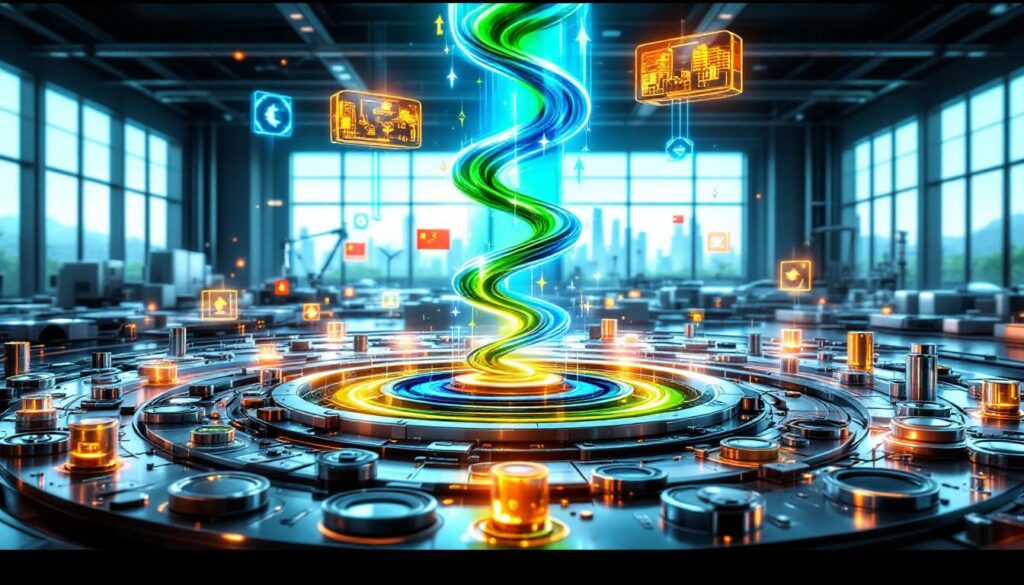Power Battery Recycling Market Growth: What's Behind the Boom
The power battery recycling industry in China is witnessing unprecedented expansion, with numerous large-scale projects springing up across multiple provinces. This growth reflects the country's strategic push toward establishing a circular economy in the clean energy sector while addressing mounting environmental concerns around battery disposal.
The Circular Economy Imperative
Battery recycling has become an urgent priority as the first generation of electric vehicle batteries reaches end-of-life. According to industry projections, China will generate over 2.5 million tons of retired lithium-ion batteries by 2030, creating both an environmental challenge and economic opportunity.
Environmental regulations are a major driver behind this recycling boom. China's Ministry of Industry and Information Technology has implemented increasingly stringent guidelines on battery manufacturers, requiring them to establish recycling networks and traceability systems for their products.
As noted in Guangzhou's recently announced 2025 funding plan, government support for "echelon use and recycling of retired power batteries" is becoming more structured and substantial, encouraging private investment in the sector.
Resource security concerns are equally important in driving recycling growth. China's push for supply chain resilience has placed strategic importance on recovering critical minerals demand surge domestically rather than relying on volatile international markets.
"Battery recycling isn't just environmentally sound—it's becoming economically essential as material costs fluctuate and supply chains face disruption," notes Dr. Li Wei, battery materials specialist at the China Renewable Energy Institute.
The Hubei 30,000-Ton Project: A Game Changer
The centerpiece of China's recycling expansion is the 30,000-ton waste lithium battery recycling project in Hubei province. This facility represents a significant technological leap forward in how battery materials are processed and recovered.
According to the Environmental Impact Assessment initiated by Yichang City Ecology and Environment Bureau, the project features five advanced intelligent production lines incorporating automation and smart management systems. This level of technological sophistication enables precise separation of valuable materials while minimizing environmental impact.
The facility's smart systems allow for real-time monitoring of resource recovery rates, energy consumption, and emissions—creating unprecedented efficiency in the recycling process. This data-driven approach is expected to establish new benchmarks for the industry nationwide.
Key project highlights:
- 30,000-ton annual processing capacity for waste lithium batteries
- Five automated production lines with smart management systems
- Advanced material separation technology for higher recovery rates
- Estimated recovery of over 3,000 tons of lithium compounds annually
- Projected to create approximately 200 specialized technical positions
The environmental benefits extend beyond waste reduction. By recovering materials like lithium, cobalt, and nickel, the project is expected to reduce the carbon footprint associated with mining waste management solutions by an estimated 60-70% compared to primary extraction.
Major Battery Recycling Projects Emerging Nationwide
The Hubei project is just one part of a broader expansion in recycling capacity across China. Several other significant projects are underway or nearing completion:
Jiangxi LFP Cathode Material Recycling Expansion
With a 210 million yuan investment, this facility is upgrading from 3,000 tons to 10,000 tons annual capacity for lithium battery electrode material recycling. What makes this project particularly innovative is its addition of a 200-ton annual capacity sodium-ion cathode production line—indicating how recycling facilities are diversifying to accommodate emerging battery chemistries.
The project includes dedicated research and development laboratories focused on improving material recovery rates and quality control protocols for recycled materials.
Hegang City's Two-Phase Development
This 120 million yuan project takes a comprehensive approach to battery recycling:
- Phase I focuses on 6,000 tons/year whole battery processing
- Phase II adds 12,000 tons/year electrode scrap handling capacity
The dual-phase approach allows the facility to process both consumer electronic batteries and production waste from manufacturing—maximizing resource recovery across the battery lifecycle.
Hubei's 68,000-Ton LFP Black Mass Recycling Facility
One of the largest investments in the sector at 2 billion yuan, this facility is nearing operational status with impressive capabilities:
- Annual recycling capacity of approximately 43,800 tons of LFP black mass
- Production capability of 25,000 tons of high-quality LFP cathode material
This project completes a regional battery lifecycle value chain, connecting material recovery directly back to cathode production in a closed-loop system.
Additional Emerging Projects
The recycling boom extends to Fujian province, where a 220-million-yuan project is being constructed to process 25,000 tons of waste LFP materials annually. This facility emphasizes multi-output resource recovery, yielding electrode powders, aluminum, copper, and other valuable components.
In Suzhou, a 50-million-yuan recycled black mass production line with 3,000 tons/year capacity includes dedicated research facilities for testing regenerated LFP cells—bridging the gap between recycling and remanufacturing.
Innovative Technologies Reshaping Battery Recycling
The industry's rapid growth is being fueled by technological innovation, with several pioneering approaches being deployed:
MIDR Low-Carbon Direct Recycling
A 3-million-yuan pilot project in Tianjin is testing MIDR (Mechanically Initiated Direct Recycling) technology, which aims to separate cathode materials from end-of-life LFP batteries with minimal energy consumption and chemical processing.
Unlike conventional pyrometallurgical or hydrometallurgical recycling methods, MIDR uses mechanical processing and direct recycling techniques that preserve the crystal structure of cathode materials—potentially reducing energy use by up to 70% compared to traditional recycling approaches.
The technology is particularly suited for LFP batteries, which contain less valuable metals than NMC chemistries but represent the dominant battery type in China's electric vehicle market.
Integrated Recycling and Production Systems
Fujian's recycling project exemplifies the trend toward integrated systems, where recycling facilities are designed to produce market-ready materials rather than intermediate products. This 25,000-ton annual capacity facility produces multiple outputs including:
- Recovered cathode materials ready for reuse
- High-purity aluminum and copper fractions
- Electrolyte components for reprocessing
- Graphite for potential energy storage applications
This integrated approach significantly improves the economics of recycling by creating multiple revenue streams from a single waste input.
LFP Precursor Projects: Expanding the Supply Chain
As recycling capacity grows, parallel expansion in precursor production is occurring to accommodate both virgin and recycled materials:
Sichuan's 100,000-Ton Technical Retrofit
This project consolidates existing sodium/ammonium-method iron phosphate capacities through a three-phase implementation across two workshops with capacities of 75,000 tons and 25,000 tons respectively.
The technical retrofit focuses on improving production efficiency and quality control, particularly for precursors that incorporate recycled materials, which can present unique processing challenges.
Guizhou's 450,000-Ton Multi-Zone Construction
With a massive 4-billion-yuan investment, this project represents one of China's largest commitments to LFP precursor production:
- Zone A: 300,000-ton capacity across 12 production lines (currently under EIA review)
- Zone B: 150,000-ton capacity across 5 production lines (planned for separate assessment)
The scale of this project underscores the anticipated growth in demand for LFP materials, driven by both new battery production and the recycling economy.
An innovative aspect of the Guizhou project is its design flexibility, allowing it to adjust production based on input material quality—whether from primary mining or recycling streams.
Government Support Driving Industry Growth
Policy support is playing a crucial role in accelerating the development of battery recycling infrastructure:
Guangzhou's 2025 Funding Plan
Guangzhou's Industry and Information Technology Bureau recently unveiled its 2025 funding plan, which specifically targets demonstration projects for the echelon use and recycling of retired power batteries.
The plan prioritizes projects that demonstrate:
- Innovative collection and sorting systems
- Advanced material recovery technologies
- Closed-loop integration with manufacturing
- Standardized quality control for recycled materials
This policy approach reflects China's broader strategy of using targeted incentives to accelerate technological development in strategic industries.
Regulatory Framework Evolution
The regulatory landscape for battery recycling is becoming increasingly sophisticated. All projects mentioned in this article have undergone or are undergoing rigorous Environmental Impact Assessments, reflecting the industry's formalization.
Public notification requirements are ensuring transparency in the development process, while technical specifications for different recycling methodologies are becoming more standardized—creating clarity for investors and operators.
Economic Opportunities in the Recycling Value Chain
The scale of investment flowing into battery recycling reflects the sector's economic promise:
Value Recovery Analysis
While specific recovery rates vary by technology and battery chemistry, modern recycling processes can recover:
- 95-98% of cobalt and nickel
- 70-80% of lithium
- Nearly 100% of copper and aluminum
- Varying amounts of graphite and electrolyte components
Based on current market prices, a ton of recycled battery black mass can yield materials worth $3,000-7,000 depending on chemistry and recovery efficiency.
Investment Landscape
The diversity of investment scales in the projects highlighted shows the sector's maturity:
- Large-scale integrated facilities (Hubei's 2-billion-yuan project)
- Mid-sized specialized operations (Jiangxi's 210-million-yuan expansion)
- Targeted technology pilots (Tianjin's 3-million-yuan MIDR project)
This variety creates entry points for different types of investors and technologies, fostering innovation across the battery metals investment value chain.
Technological Innovation Beyond Recycling
Battery recycling is not just advancing material recovery—it's spurring broader technological innovation:
Research and Development Initiatives
Suzhou's dedicated R&D center for regenerated LFP test cells exemplifies how recycling is driving innovation in battery design and testing. These facilities are developing protocols to verify the performance of cells made with recycled materials, addressing key concerns about longevity and safety.
Process optimization research is yielding benefits beyond recycling, including:
- Energy efficiency improvements applicable to primary production
- Advanced sorting technologies using machine learning
- Non-destructive testing methods for battery evaluation
- Material purification techniques relevant to mining operations
Integration with Battery Manufacturing
As recycling scales up, battery manufacturers are adapting their designs to facilitate easier disassembly and material recovery—creating a virtuous cycle of innovation.
Quality standards for recycled materials are becoming more rigorous, with traceability systems being developed to track recycled content from collection through to new battery production.
Several major battery manufacturers are establishing partnerships with recyclers to secure material supply and meet regulatory requirements for recycled content, creating stable demand for recovered materials. Recent developments in Panasonic closed-loop recycling programs demonstrate how major industry players are embracing this approach.
FAQ: Power Battery Recycling
What types of batteries are being recycled in these facilities?
Most projects in China focus primarily on lithium iron phosphate (LFP) batteries, which dominate the Chinese electric vehicle and energy storage markets. This chemistry represents approximately 80% of the current EV battery market in China.
Some facilities also process other lithium-ion chemistries including those containing cobalt, nickel, and manganese (NMC), though these represent a smaller portion of the market. Consumer electronics batteries (primarily lithium cobalt oxide) are often processed in dedicated lines due to their different form factors and chemistry.
How does battery recycling contribute to sustainability?
Battery recycling delivers multiple sustainability benefits:
- Resource conservation: Reduces primary mining of critical minerals like lithium, cobalt, and nickel
- Pollution prevention: Keeps hazardous materials out of landfills and incinerators
- Carbon reduction: Recycled materials typically have 60-70% lower carbon footprint than virgin materials
- Energy savings: Producing cathode materials from recycled sources consumes significantly less energy
- Circular economy: Creates a closed-loop system that minimizes waste and maximizes resource efficiency
What is black mass in battery recycling?
Black mass is the dark, powdery material produced after batteries are shredded and processed to remove casings, separators, and some electrolyte components. It contains valuable metals including lithium, cobalt, nickel, and manganese in mixed oxide or salt forms.
This intermediate product requires further processing through hydrometallurgical or pyrometallurgical methods to separate and purify the individual metals for reuse in new batteries. The value of black mass varies significantly based on its metal content, which depends on the original battery chemistry.
How does the economics of battery recycling compare to mining?
As recycling technologies improve and achieve economies of scale, recovering materials from spent batteries is becoming increasingly competitive with mining, especially for elements like cobalt and nickel that have high market values.
Current analysis suggests that:
- For high-cobalt batteries, recycling is already economically favorable
- For LFP batteries, recycling economics improve when facilities are scaled and integrated with production
- As primary ore grades decline globally, recycling's comparative advantage is strengthening
- Recycling provides price stability advantages, being less affected by geopolitical disruptions
The economic equation continues to improve as collection systems mature and processing technologies advance, with many analysts projecting recycling to become the preferred source for battery materials within the next decade. China's Chinese battery recycling breakthrough technologies are leading this transition globally.
Want to Know About the Next Major Mineral Discovery Before the Market Does?
Discovery Alert's proprietary Discovery IQ model delivers real-time notifications on significant ASX mineral discoveries, transforming complex data into actionable investment opportunities. Explore how historic discoveries have generated exceptional returns by visiting the Discovery Alert discoveries page and position yourself ahead of the market with a 30-day free trial.




